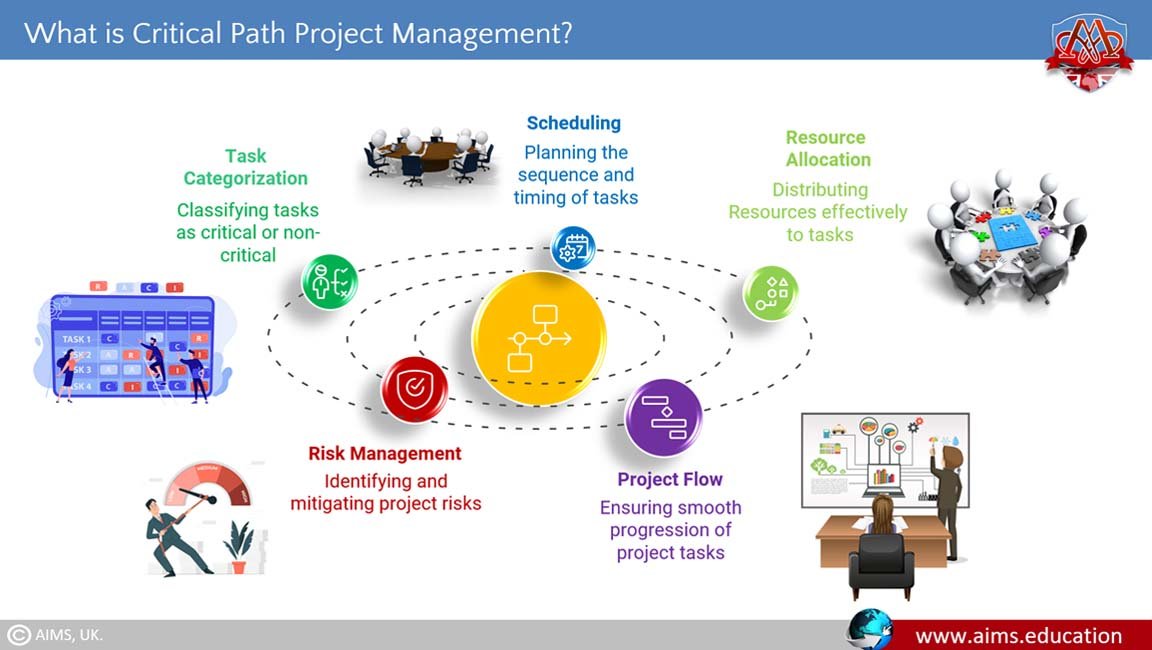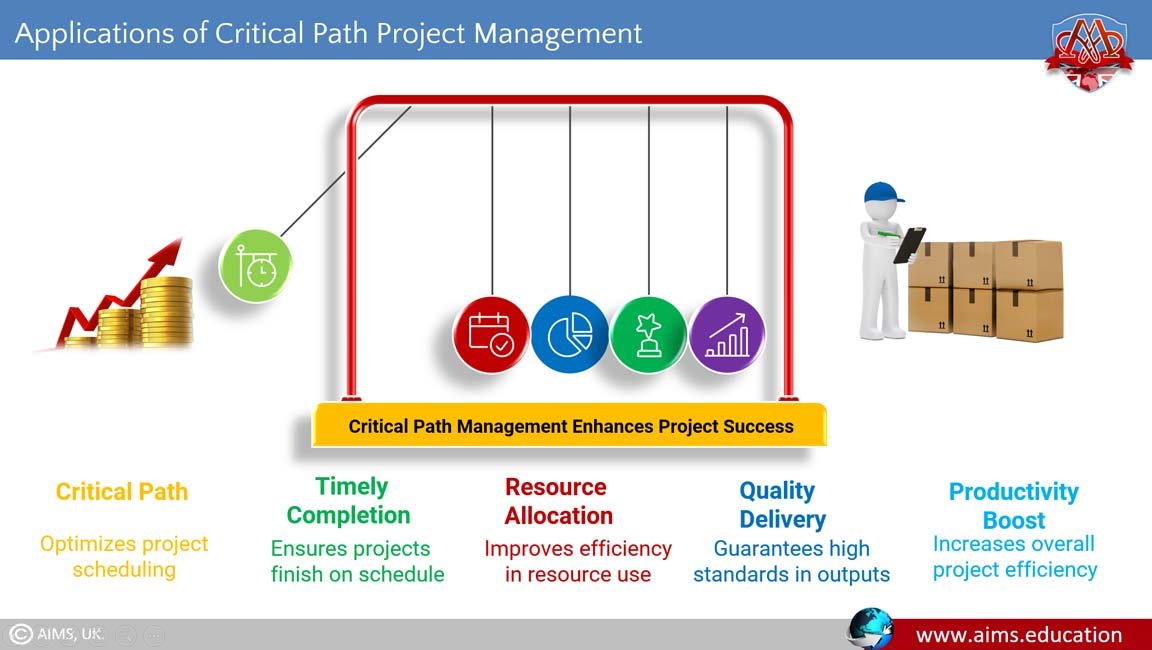What is Critical Path in Project Management?
Critical path project management is a sophisticated method that is used to plan, schedule, determine the order of tasks, and estimate the extended time required to finish a project from beginning to end. The critical path provides an exact duration for the project’s completion. Tasks are categorized as either critical or non-critical in critical path project management. Critical tasks must be finished on time because delays would impact the project’s overall time frame. Meanwhile, non-critical tasks are less likely to create delays and offer greater flexibility. For projects with various interconnected tasks, the critical path assists project managers in identifying bottlenecks and allocating resources.
- Critical path project management facilitates work prioritization, risk reduction, and enhanced project flow.
- The critical path in project management is an essential tool, providing improved planning, risk management, resource allocation, and teamwork to guarantee project completion on schedule.
Components of Critical Path Project Management
There are two primary parts of the project management critical path. They are: Time and Schedule management.
1. Critical Time Management
It contributes to project managers recognizing that the activities have a significant impact on the project’s completion.
2. Effective Schedule Management
It assists project managers in creating effective scheduling that enables them to complete the full project on budget and schedule.
How to Implement Critical Path in Project Management?
The following are steps for implementation of the critical path in project management:
Step 1: Create a Work Breakdown Structure (WBS)
Creating a work breakdown structure (WBS), which is a list of all the tasks or activities to enumerate every work that falls within the project’s scope.
Step 2: Determine Task Timeline and Duration
For precise timeframes, estimate the amount of time needed for each activity based on past performance or professional judgment.
Step 3: Create a Network Diagram
Map out the tasks and their dependencies using a visual diagram.
Step 4: Use the Critical Path Formula
Emphasize on team duties to ensure responsibility and clarity.
Step 5: Calculate the Float
Determine the critical path with zero float by calculating the earliest and latest start and finish timings for each activity.

Example of the Critical Path Project Management
We shall now illustrate the critical path in project management with a straightforward, real-world approach using the example of organizing a party. The critical path in project management is summarized as follows:
1. Define the Project Scope
Enumerate all the tasks required to finish it. Tasks include:
- Choose a date and venue
- Invite friends
- Buy food and drinks
- Cook casserole
- Organizing the entertainment
These tasks identify the critical path. So, they should be performed in sequence.
2. Define Different Project Paths
Determine the dependencies between the parallel task routes. For instance, while some procedures, like reserving the space, must be completed in order, other duties, like organizing the entertainment (like hiring a DJ), must be completed concurrently.
3. Consider Resource Constraints
Assignments can be split up (e.g., one person gets food, and another builds a playlist). Because of time and effort constraints, tasks such as selecting a date, inviting people, and purchasing food must be completed in order.
4. Calculate Project Duration
To estimate the length of the project, add the times for all important jobs. For example, the critical path takes three days and 8 hours, excluding non-critical path work, like creating a playlist.
5. Leave Space for Flexibility
Non-critical tasks, like selecting drapes for redecoration, have a float, which allows them to be postponed without affecting the project’s success.
6. Adjust to Changes
Since delays can cause non-essential jobs to move on the critical path, monitor them. For instance, if selecting curtains takes too long, it can end up on the critical path.
7. Compress the Schedule
Within the critical path framework, schedule compression can be achieved in two ways, albeit this is not the best option:
a. Fast-Tracking
To reduce project length, this technique entails overlapping simultaneous tasks that were initially intended to be completed sequentially. Because of task interdependence, fast-tracking may make a project riskier.
b. Crashing
It is allocating more resources (such as labor or equipment) to crucial tasks to do them more quickly. Notifying stakeholders of any budget adjustments is crucial because crashes frequently result in higher expenses.

Critical Path Project Management in Practice
Applications of Critical Path Project Management
Because of its adaptable approach to project scheduling, critical paths can be used for a wide range of project types and sectors. Here are some important uses and illustrations of the critical path in project management:
1. Construction
When it comes to overseeing construction projects like electrical installation, framing, and foundation work, a project management critical path is crucial. By recognizing important tasks and making the most use of available resources, it guarantees on-time completion.
2. Software Development
Critical path project management identifies critical dependencies in coding, testing, and deployment. It assists groups in setting priorities and allocating resources, guaranteeing timely and excellent delivery of software.
3. Manufacturing
Critical path project management optimizes interdependent steps, such as the acquisition and assembly of raw materials. It enhances inventory control, production scheduling, and productivity for on-time delivery.
6 Practical Tips for Managing Critical Path Project Management
Continuous management is essential to optimize the advantages of the critical path in project management. The following best practices will guarantee a seamless critical path implementation:
1. Update Frequently
Regularly review critical path calculations and diagrams to guarantee accuracy and account for changes in work length.
2. Track Development
To spot and address delays early, keep a tight focus on critical route tasks.
3. Use Effective Communication
To guarantee cooperation and alignment, stakeholders must know the important path and dependencies. Set up alerts for task updates automatically.
4. Control Hazards Actively
Determine the risks associated with important tasks and develop backup strategies to reduce their influence on the schedule.
5. Make Use of Teamwork Resources
To make critical paths more efficient, use systems for automated notifications, task tracking, and dependency management.
6. Put an Emphasis on Constant Development
Examine previous projects and improve the estimating critical path procedures for more effective use in the future.

Advantages of the Critical Path in Project Management
Critical path project management is an essential part of educational programs offered by AIMS’ institute of project management. These programs include the Certified Project Manager certification, an online diploma of project management, and a Master’s degree in project management online. Following are some advantages of the critical path in project management discussed below:
1. Visualization Project Timeline
The critical path gives project managers a thorough grasp of the project’s flow by showing the order and length of each activity, which facilitates efficient resource planning and management.
2. Identifies Critical Tasks
This facilitates proactive control of possible delays, aiding in work prioritization.
3. Risk Identification and Mitigation
Project managers should anticipate possible delays or bottlenecks and take proactive steps to reduce risks by emphasizing the important path.
4. Enhanced Communication
Enhanced communication between team members gives a better understanding of their roles and responsibilities, and how their tasks affect the project as a whole if they have a clear visual representation of the timeframe. This may result in increased cooperation, effectiveness, and project success in general.
5 Limitations of Critical Path Project Management
Despite being a strong method for project scheduling, project management has drawbacks and restrictions. Here are a few imperative areas to think about:
1. Intricacy
Calculations for the critical route and float might be time-consuming due to the complexity of critical path project management in large projects with numerous jobs and dependencies.
2. Limited Use
Critical path project management may not be appropriate for projects with significant uncertainty, such as Agile project management.
3. Pay Attention to the Critical Path
Critical jobs are prioritized by critical path project management, which could result in neglecting work with longer float times, missing deadlines, or wasting resources.
4. Difficulties with Estimation
Estimating task length accurately is essential, but it can be challenging, particularly for complicated or unique tasks. Delays may result from inaccurate estimations.
5. Dependency on Software
Although project management software makes critical path calculations easier, relying too much on it makes it more difficult to grasp the approach, which is essential for making wise decisions.
